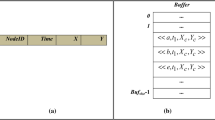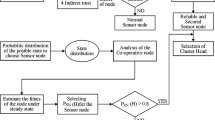Abstract
Due to the broadcast nature of wireless communication, wireless sensor networks (WSNs) are susceptible to several attacks. Amongst them, replica attack is one of the predominates as it facilitates the attackers to perform some other attacks. So, it is of immense significance to design a competent security method for WSNs. Introducing a trust method is the primary concern for assisting well-organized use of the available energy in each node in the energy restricted environment. In order to tradeoff between energy usage and attack detection, energy-based prediction approach is deemed to be a suitable one. A statistical method, exponential moving average (EMA) model based replica detection is proposed to detect replica node attack based on energy consumption threshold in WSNs. The difference between actual and predicted energy consumption exceeding the threshold level is considered as malicious. In this paper, future energy drop of a sensor node is forecasted using statistical measure instead of probabilistic method. In EMA model, the transition from higher power consuming state (active state) to lower power consuming states (sleep and sense states) is controlled by a fixed schedule. The accumulated average time of the node was in any state in the past is used to estimate the time duration of a node that spends in that state. Unlike Markov Model, the estimations of energy are made periodically. By this, computational overhead on the microcontroller of the sensor is greatly reduced in EMA approach. The simulation results taken using TRM simulator shows that choosing the threshold value which is neither too large nor too small results in optimum level of detection accuracy and lifetime of the network.






Similar content being viewed by others
References
Andrysiak, T., Saganowski, Ł., & Kiedrowski, P. (2017). Anomaly detection in smart metering infrastructure with the use of time series analysis. Journal of Sensors, 2017, 1–5.
Sakhnini, J., Karimipour, H., Dehghantanha, A., Parizi, R. M., & Srivastava, G. (2019). Security aspects of Internet of Things aided smart grids: A bibliometric survey. Internet of Things. https://doi.org/10.1016/j.iot.2019.100111.
Rajadurai, H., & Gandhi, U. D. (2020). Fuzzy based collaborative verification system for Sybil attack detection in MANET. Wireless Personal Communications, 110(4), 2179–2193.
Engmann, F., Katsriku, F. A., Abdulai, J.-D., Adu-Manu, K. S., & Banaseka, F. K. (2018). Prolonging the lifetime of wireless sensor networks: A review of current techniques. Wireless Communications and Mobile Computing, 2018, 1–23. https://doi.org/10.1155/2018/8035065.
Alrajei, N., Corser, G., Fu, H., & Zhu, Y. (2014). Energy prediction based intrusion detection in wireless sensor networks. International Journal of Emerging Technology and Advanced Engineering, 4(2), 760–767.
Jinhui, X., Yang, T., Feiyue, Y., Leina, P., Juan, X., & Yao, H. (2018). Intrusion detection system for hybrid DoS attacks using energy trust in wireless sensor networks. Procedia computer science, 131, 1188–1195.
Numan, M., Subhan, F., Khan, W. Z., Hakak, S., Haider, S., Reddy, G. T., et al. (2020). A systematic review on clone node detection in static wireless sensor networks. IEEE Access, 8, 65450–65461.
Pundir, S., Wazid, M., Singh, D. P., Das, A. K., Rodrigues, J. J. P. C., & Park, Y. (2020). Intrusion detection protocols in wireless sensor networks integrated to Internet of Things deployment: Survey and future challenges. IEEE Access, 8, 3343–3363. https://doi.org/10.1109/ACCESS.2019.2962829.
Machaka, P., Bagula, A., & Nelwamondo, F. (2017). Using exponentially weighted moving average algorithm to defend against DDoS attacks. In 2016 Pattern recognition association of South Africa and robotics and mechatronics international conference (PRASA-RobMech), 2017 (pp. 1–6). IEEE.
Cheng, H., Xie, Z., Shi, Y., & Xiong, N. (2019). Multi-step data prediction in wireless sensor networks based on one-dimensional CNN and bidirectional LSTM. IEEE Access, 7, 117883–117896.
Devi, P., & Jaison, B. (2020). Protection on wireless sensor network from clone attack using the SDN-enabled hybrid clone node detection mechanisms. Computer Communications, 152, 316–322.
Han, G., Jiang, J., Shen, W., Shu, L., & Rodrigues, J. (2013). IDSEP: A novel intrusion detection scheme based on energy prediction in cluster-based wireless sensor networks. IET Information Security, 7(2), 97–105.
Yu, Q., Jibin, L., & Jiang, L. (2016). An improved ARIMA-based traffic anomaly detection algorithm for wireless sensor networks. International Journal of Distributed Sensor Networks, 12(1), 1–9.
Mini, R. A., Nath, B., & Loureiro, A. A. (2002). A probabilistic approach to predict the energy consumption in wireless sensor networks. In IV Workshop de comunicao sem Fio e computao Mvel, 2002 (pp. 23–25).
Mini, R. A., do Val Machado, M., Loureiro, A. A., & Nath, B. (2005). Prediction-based energy map for wireless sensor networks. Ad Hoc Networks, 3(2), 235–253.
Maivizhi, R., & Yogesh, P. (2020). Concealed multidimensional data aggregation in big data wireless sensor networks. In Proceedings of the 7th ACM IKDD CoDS and 25th COMAD (pp. 19–27).
Han, G., Shen, W., Duong, T. Q., Guizani, M., & Hara, T. (2014). A proposed security scheme against denial of service attacks in cluster-based wireless sensor networks. Security and Communication Networks, 7(12), 2542–2554.
Osanaiye, O., Alfa, A. S., & Hancke, G. P. (2018). A statistical approach to detect jamming attacks in wireless sensor networks. Sensors, 18(6), 1691.
Sharma, H., Haque, A., & Jaffery, Z. A. (2018). Solar energy harvesting wireless sensor network nodes: A survey. Journal of Renewable and Sustainable Energy, 10(2), 023704.
Jiang, Z., Jin, X., & Zhang, Y. (2010). A weather-condition prediction algorithm for solar-powered wireless sensor nodes. In 2010 6th international conference on wireless communications networking and mobile computing (WiCOM), 2010 (pp. 1–4). IEEE.
Nurgaliyev, M., Saymbetov, A., Yashchyshyn, Y., Kuttybay, N., & Tukymbekov, D. (2020). Prediction of energy consumption for LoRa based wireless sensors network. Wireless Networks, 26(5), 3507–3520. https://doi.org/10.1007/s11276-020-02276-5.
Priyadarshi, R., Gupta, B., & Anurag, A. (2020). Wireless sensor networks deployment: A result oriented analysis. Wireless Personal Communications. https://doi.org/10.1007/s11277-020-07255-9.
Dhillon, S., Madhu, C., Kaur, D., & Singh, S. (2020). A solar energy forecast model using neural networks: Application for prediction of power for wireless sensor networks in precision agriculture. Wireless Personal Communications, 112, 2741–2760. https://doi.org/10.1007/s11277-020-07173-w.
Shanmugam, M., & Ramasamy, A. (2014). Sensor-based turmeric finger growth characteristics monitoring using embedded system under soil. International Journal of Distributed Sensor Networks, 10(6), 476176.
Shanmugam, M., Ramasamy, A., Paramasivam, S., & Prabhakaran, P. (2016). Monitoring the turmeric finger disease and growth characteristics using sensor based embedded system—A novel method. Circuits and Systems, 7(08), 1280.
Hill, J. R., Szewczyk, A. Woo, Hollar, S. Culler, D., & Pister, K. (2000). System architecture directions for networked sensors. In Proceedings of the 9th ACM international conference on architectural support for programming languages and operating systems, 2000. (pp. 93–104). New York: ACM Press.
Funding
The research work was partially funded by University Grants Commission (UGC/Government of India) South Eastern Regional Office, Hyderabad under Minor Research Grant with P.No:3620.
Author information
Authors and Affiliations
Corresponding author
Additional information
Publisher's Note
Springer Nature remains neutral with regard to jurisdictional claims in published maps and institutional affiliations.
Rights and permissions
About this article
Cite this article
Anitha, S., Jayanthi, P. & Thangarajan, R. Detection of Replica Node Attack Based on Exponential Moving Average Model in Wireless Sensor Networks. Wireless Pers Commun 115, 1651–1666 (2020). https://doi.org/10.1007/s11277-020-07648-w
Published:
Issue Date:
DOI: https://doi.org/10.1007/s11277-020-07648-w




